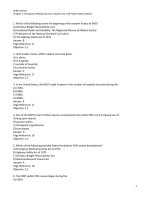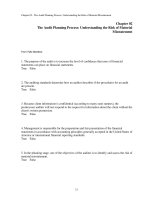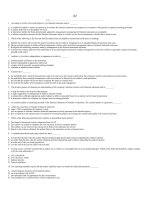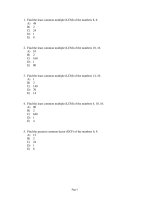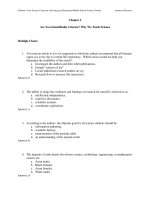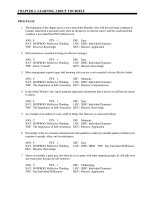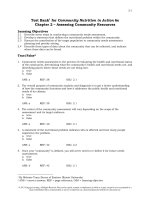Building management skills an action first approach 1st edition daft test bank
Bạn đang xem bản rút gọn của tài liệu. Xem và tải ngay bản đầy đủ của tài liệu tại đây (166.63 KB, 11 trang )
CHAPTER 2- LEARNING ABOUT YOURSELF
TRUE/FALSE
1. The beginning of the chapter gives a story about John Bearden, who sold his real estate company in
Canada. John hired a personal coach when he decided to re-start his career, and the coach had John
complete a test called the ENTJ indicator test.
ANS: F
PTS: 1
NAT: BUSPROG: Reflective Thinking
TOP: Discover Knowledge
DIF: Easy
LOC: DISC: Individual Dynamics
KEY: Bloom's: Application
2. Self-awareness is essential to being an effective manager.
ANS: T
PTS: 1
NAT: BUSPROG: Reflective Thinking
TOP: Know Yourself
DIF: Easy
LOC: DISC: Individual Dynamics
KEY: Bloom's: Knowledge
3. Most management experts agree that knowing who you are is not essential to be an effective leader.
ANS: F
PTS: 1
DIF: Moderate
NAT: BUSPROG: Reflective Thinking
LOC: DISC: Individual Dynamics
TOP: The Importance of Self-Awareness KEY: Bloom's: Comprehension
4. In the Johari Window, the “open”quadrant represents information that is known to self but not known
to others.
ANS: F
PTS: 1
DIF: Easy
NAT: BUSPROG: Reflective Thinking
LOC: DISC: Individual Dynamics
TOP: The Importance of Self-Awareness KEY: Bloom's: Knowledge
5. An example of an unknown issue could be things like illnesses or repressed feelings.
ANS: T
PTS: 1
DIF: Moderate
NAT: BUSPROG: Reflective Thinking
LOC: DISC: Individual Dynamics
TOP: The Importance of Self-Awareness KEY: Bloom's: Application
6. Personality is the set of unseen characteristics that underlie a relatively unstable pattern of behavioral
response to people, ideas, and circumstances.
ANS: F
PTS: 1
NAT: BUSPROG: Reflective Thinking
KEY: Bloom's: Knowledge
DIF: Easy
LOC: DISC: HRM TOP: Key Individual Differences
7. Simon is normally a quiet guy, but when he is at a party with other outgoing people, he will talk more
and crack jokes because he self-monitors.
ANS: T
PTS: 1
NAT: BUSPROG: Reflective Thinking
TOP: Key Individual Differences
DIF: Challenging
LOC: DISC: Individual Dynamics
KEY: Bloom's: Application
8. Extroverts gain energy from being around people and interacting with others whereas introverts gain
energy when away from other people.
ANS: T
PTS: 1
NAT: BUSPROG: Reflective Thinking
TOP: Key Individual Differences
DIF: Easy
LOC: DISC: Individual Dynamics
KEY: Bloom's: Comprehension
9. Instrumental values are sometimes called terminal values.
ANS: F
PTS: 1
NAT: BUSPROG: Reflective Thinking
TOP: Underlying Values
DIF: Easy
LOC: DISC: Individual Dynamics
KEY: Bloom's: Knowledge
10. Abraham Maslow refers to the mastery of any skill as conscious competence.
ANS: F
PTS: 1
DIF: Moderate
NAT: BUSPROG: Reflective Thinking
LOC: DISC: Individual Dynamics
TOP: Using Self-Awareness to Build Management Skills
KEY: Bloom's: Knowledge
MULTIPLE CHOICE
1. In the introduction story about John Bearden, what enabled John to discover the productive and
nonproductive patterns and preferences of which he was not aware?
a. therapy with his personal coach
c. worked on his weaknesses
b. systematic self-inquiry
d. working more hours
ANS: B
PTS: 1
LOC: DISC: Leadership Principles
KEY: Bloom's: Analysis
DIF: Moderate
NAT: BUSPROG: Communication
TOP: Discover Knowledge
2. It is difficult to see one’s own characteristics ____.
a. objectively
c. clearly
b. subjectively
d. all of these
ANS: A
PTS: 1
NAT: BUSPROG: Reflective Thinking
TOP: Know Yourself
DIF: Easy
LOC: DISC: Individual Dynamics
KEY: Bloom's: Knowledge
3. ___ means being aware of the internal aspects of one’s nature.
a. Objectivity
c. Self-thought
b. Internal awareness
d. Self-awareness
ANS: D
PTS: 1
NAT: BUSPROG: Reflective Thinking
TOP: Know Yourself
DIF: Easy
LOC: DISC: Individual Dynamics
KEY: Bloom's: Knowledge
4. If you are a natural at math and dislike counseling people, which career would be best for you?
a. Bus driver
c. Therapist
b. Financial analyst
d. Dentist
ANS: B
PTS: 1
NAT: BUSPROG: Reflective Thinking
TOP: Know Yourself
DIF: Moderate
LOC: DISC: Individual Dynamics
KEY: Bloom's: Application
5. Numerous philosophers and behavioral scientists have pointed to the importance of ___ for living a
full, rewarding life.
a. education
c. self-knowledge
b. relationships
d. money
ANS: C
PTS: 1
DIF: Moderate
NAT: BUSPROG: Reflective Thinking
LOC: DISC: Leadership Principles
TOP: The Importance of Self-Awareness KEY: Bloom's: Comprehension
6. Studies show that people would much rather follow someone they ____, even when they disagree with
that person’s viewpoint, than someone who frequently shifts her ideas.
a. think is powerful
c. believe in
b. look up to
d. can count on
ANS: D
PTS: 1
DIF: Easy
NAT: BUSPROG: Reflective Thinking
LOC: DISC: Leadership Principles
TOP: The Importance of Self-Awareness KEY: Bloom's: Knowledge
7. How can you enhance your self-awareness?
a. solicit feedback
b. self-diagnose
c. self-disclose
d. all of these
ANS: D
PTS: 1
DIF: Moderate
NAT: BUSPROG: Reflective Thinking
LOC: DISC: Leadership Principles
TOP: The Importance of Self-Awareness KEY: Bloom's: Application
8. What term means “our perceptions of ourselves are shaped partly by how others perceive us”?
a. social mirror
c. person mirror
b. self-diagnose
d. mirror diagnosis
ANS: A
PTS: 1
DIF: Easy
NAT: BUSPROG: Reflective Thinking
LOC: DISC: Leadership Principles
TOP: The Importance of Self-Awareness KEY: Bloom's: Knowledge
9. What term means “using self-inquiry and reflection to gain insights into yourself from self-assessment
results”?
a. soliciting feedback
c. self-disclosure
b. self-diagnosis
d. social mirror
ANS: B
PTS: 1
DIF: Easy
NAT: BUSPROG: Reflective Thinking
LOC: DISC: Leadership Principles
TOP: The Importance of Self-Awareness KEY: Bloom's: Knowledge
10. Sarah writes daily in a journal to record her thoughts of what is going well in her life. What method of
self-awareness is Sarah using?
a. soliciting feedback
c. self-disclosure
b. self-diagnose
d. all of these
ANS: B
PTS: 1
DIF: Challenging
NAT: BUSPROG: Reflective Thinking
LOC: DISC: Leadership Principles
TOP: The Importance of Self-Awareness KEY: Bloom's: Application
11. ____ means sharing your fears, thoughts, emotions and concepts of yourself with others.
a. Soliciting feedback
c. Self-disclosure
b. Self-diagnose
d. all of these
ANS: C
PTS: 1
DIF: Easy
NAT: BUSPROG: Reflective Thinking
LOC: DISC: Leadership Principles
TOP: The Importance of Self-Awareness KEY: Bloom's: Knowledge
12. People who practice ____ to others are emotionally healthier and happier than people who don’t tell
others about their life.
a. soliciting feedback
c. self-disclosure
b. self-diagnosis
d. self-infliction
ANS: C
PTS: 1
DIF: Easy
NAT: BUSPROG: Reflective Thinking
LOC: DISC: Leadership Principles
TOP: The Importance of Self-Awareness KEY: Bloom's: Comprehension
13. ____ is a tool managers can use to move toward greater transparency and alignment with others.
a. Luham Window
c. Joseph Luft Window
b. Harry Ingham Window
d. Johari Window
ANS: D
PTS: 1
DIF: Easy
NAT: BUSPROG: Reflective Thinking
LOC: DISC: Leadership Principles
TOP: The Importance of Self-Awareness KEY: Bloom's: Knowledge
14. Which quadrant of the Johari Window includes things that are known about an individual by others but
are unknown to the individual himself?
a. I
c. III
b. II
d. IV
ANS: B
PTS: 1
DIF: Easy
NAT: BUSPROG: Reflective Thinking
LOC: DISC: Leadership Principles
TOP: The Importance of Self-Awareness KEY: Bloom's: Knowledge
15. Which quadrant of the Johari Window is know as the “blind” quadrant?
a. I
c. III
b. II
d. IV
ANS: B
PTS: 1
DIF: Easy
NAT: BUSPROG: Reflective Thinking
LOC: DISC: Leadership Principles
TOP: The Importance of Self-Awareness KEY: Bloom's: Knowledge
16. Which quadrant of the Johari Window represents things that an individual knows about himself but
keeps hidden from others?
a. open
c. hidden
b. blind
d. unknown
ANS: C
PTS: 1
DIF: Easy
NAT: BUSPROG: Reflective Thinking
LOC: DISC: Leadership Principles
TOP: The Importance of Self-Awareness KEY: Bloom's: Knowledge
17. How can people shrink the unknown quadrant of the Johari Window?
a. seeking feedback from others
c. neither of these
b. disclosing more about themselves
d. both of these
ANS: D
PTS: 1
DIF: Moderate
NAT: BUSPROG: Reflective Thinking
LOC: DISC: Leadership Principles
TOP: The Importance of Self-Awareness KEY: Bloom's: Analysis
18. Which of the following are not one of the four keys to self-awareness?
a. motivation
b. personality
ANS: A
PTS: 1
NAT: BUSPROG: Reflective Thinking
TOP: Key Individual Differences
c. thinking style
d. interaction with the world
DIF: Challenging
LOC: DISC: Leadership Principles
KEY: Bloom's: Synthesis
19. ____ is the set of unseen characteristics and thought processes that underlie a relatively stable pattern
of behavioral response to people, ideas, and circumstances.
a. Motivation
c. Thinking style
b. Personality
d. Interaction with the world
ANS: B
PTS: 1
NAT: BUSPROG: Reflective Thinking
TOP: Key Individual Differences
DIF: Easy
LOC: DISC: Leadership Principles
KEY: Bloom's: Knowledge
20. What model of personality groups the myriad of personality traits into the main key dimensions?
a. Four Key Model
c. Big Four Model
b. Johari Window Model
d. Big Five Model
ANS: D
PTS: 1
NAT: BUSPROG: Reflective Thinking
TOP: Key Individual Differences
DIF: Easy
LOC: DISC: Leadership Principles
KEY: Bloom's: Knowledge
21. Someone low on ____ might come across as withdrawn and quiet.
a. conscientiousness
c. extraversion
b. agreeableness
d. introversion
ANS: C
PTS: 1
NAT: BUSPROG: Reflective Thinking
TOP: Key Individual Differences
DIF: Moderate
LOC: DISC: Leadership Principles
KEY: Bloom's: Comprehension
22. Sidd is a good natured, likeable, and cooperative person. Sidd is high in ____.
a. conscientiousness
c. extraversion
b. agreeableness
d. emotional stability
ANS: B
PTS: 1
NAT: BUSPROG: Reflective Thinking
TOP: Key Individual Differences
DIF: Moderate
LOC: DISC: Leadership Principles
KEY: Bloom's: Application
23. A person low in ____ is disorganized, unreliable, and easily distracted.
a. conscientiousness
c. extraversion
b. agreeableness
d. emotional stability
ANS: A
PTS: 1
NAT: BUSPROG: Reflective Thinking
TOP: Key Individual Differences
DIF: Easy
LOC: DISC: Leadership Principles
KEY: Bloom's: Knowledge
24. _____ is the degree to which a person has a broad range of interests and is curious.
a. Openness to experience
c. Extraversion
b. Agreeableness
d. Emotional stability
ANS: A
PTS: 1
NAT: BUSPROG: Reflective Thinking
TOP: Key Individual Differences
DIF: Easy
LOC: DISC: Leadership Principles
KEY: Bloom's: Knowledge
25. Which trait(s) would benefit a sales manager most?
a. Openness to experience
c. Conscientiousness, Extraversion
b. Agreeableness, Extraversion
d. Emotional stability
ANS: B
PTS: 1
NAT: BUSPROG: Reflective Thinking
TOP: Key Individual Differences
DIF: Challenging
LOC: DISC: Leadership Principles
KEY: Bloom's: Evaluation
26. The ability to adjust behavior relative to shifting demands of work or social situations is called _____.
a. Herrmann monitoring
c. self-monitoring
b. behavior adjustability
d. emotional stability
ANS: C
PTS: 1
NAT: BUSPROG: Reflective Thinking
TOP: Key Individual Differences
DIF: Easy
LOC: DISC: Leadership Principles
KEY: Bloom's: Knowledge
27. A person’s ____ is how they perceive, process and use information, which affects how they solve
problems and make decisions.
a. cognitive style
c. self-monitoring
b. behavior adjustability
d. thinking style
ANS: D
PTS: 1
NAT: BUSPROG: Reflective Thinking
TOP: Key Individual Differences
DIF: Easy
LOC: DISC: Leadership Principles
KEY: Bloom's: Knowledge
28. The left side of the brain processes ____ and the right side processes ____.
a. logical thoughts; creative thoughts
c. details; quantitative thoughts
b. creative thoughts; logical thoughts
d. visual images; written language
ANS: A
PTS: 1
NAT: BUSPROG: Reflective Thinking
TOP: Key Individual Differences
DIF: Easy
LOC: DISC: Leadership Principles
KEY: Bloom's: Comprehension
29. What model breaks down a person’s thinking style into four quadrants?
a. Four Key Model
c. Whole Brain Model
b. Johari Window Model
d. Big Five Model
ANS: C
PTS: 1
NAT: BUSPROG: Reflective Thinking
TOP: Key Individual Differences
DIF: Easy
LOC: DISC: Leadership Principles
KEY: Bloom's: Knowledge
30. According to Herrmann’s Whole Brain Model, which quadrant deals with planning, organizing facts
and reviewing details?
a. Quadrant A
c. Quadrant C
b. Quadrant B
d. Quadrant D
ANS: B
PTS: 1
NAT: BUSPROG: Reflective Thinking
TOP: Key Individual Differences
DIF: Easy
LOC: DISC: Leadership Principles
KEY: Bloom's: Comprehension
31. According to Herrmann’s Whole Brain Model, a person with a ____ preference is imaginative and
likes to take risks.
a. Quadrant A
c. Quadrant C
b. Quadrant B
d. Quadrant D
ANS: D
PTS: 1
DIF: Easy
NAT: BUSPROG: Reflective Thinking
TOP: Key Individual Differences
LOC: DISC: Leadership Principles
KEY: Bloom's: Knowledge
32. Vanessa is a high level manager in her company. Which brain quadrant should most of her thoughts
come from?
a. Quadrant A
b. she should have a balanced thinking style
c. Quadrant C
d. she should not follow any of the 4 quadrants
ANS: B
PTS: 1
NAT: BUSPROG: Reflective Thinking
TOP: Key Individual Differences
DIF: Moderate
LOC: DISC: Leadership Principles
KEY: Bloom's: Application
33. The ____ provides a way of measuring differences among individuals in their psychological
preferences for how they interact with others and perceive the world.
a. Johari Window
c. MITB
b. Big 5 Model
d. MBTI
ANS: D
PTS: 1
NAT: BUSPROG: Reflective Thinking
TOP: Key Individual Differences
DIF: Moderate
LOC: DISC: Leadership Principles
KEY: Bloom's: Knowledge
34. According to the Myers-Briggs Type Indicator assessment, ____ identifies how a person absorbs
information.
a. introversion versus extraversion
c. thinking versus feeling
b. sensing versus intuition
d. judging verses perceiving
ANS: B
PTS: 1
NAT: BUSPROG: Reflective Thinking
TOP: Key Individual Differences
DIF: Easy
LOC: DISC: Leadership Principles
KEY: Bloom's: Knowledge
35. According to the Myers-Briggs Type Indicator assessment, ____ relates to how a person makes
decisions, especially whether emotions play a role.
a. introversion versus extraversion
c. thinking versus feeling
b. sensing versus intuition
d. judging verses perceiving
ANS: C
PTS: 1
NAT: BUSPROG: Reflective Thinking
TOP: Key Individual Differences
DIF: Easy
LOC: DISC: Leadership Principles
KEY: Bloom's: Knowledge
36. ____ type people are in the majority in fields where the focus is on the immediate and tangible.
a. Perceiving
c. Intuition
b. Judging
d. Sensing
ANS: D
PTS: 1
NAT: BUSPROG: Reflective Thinking
TOP: Key Individual Differences
DIF: Easy
LOC: DISC: Leadership Principles
KEY: Bloom's: Comprehension
37. What preference(s) seem to be most strongly associated with successful management?
a. Thinking
c. Thinking and Judging
b. Judging
d. Sensing and Extraversion
ANS: C
PTS: 1
NAT: BUSPROG: Reflective Thinking
TOP: Key Individual Differences
DIF: Challenging
LOC: DISC: Leadership Principles
KEY: Bloom's: Analysis
38. ____ are fundamental beliefs that individual considers to be important, that are stable over time, and
that influence behavior.
a. Values
c. Instrumental values
b. End values
d. Attitudes
ANS: A
PTS: 1
NAT: BUSPROG: Reflective Thinking
TOP: Underlying Values
39. End values are sometimes called ____.
a. behavioral values
b. beliefs
ANS: D
PTS: 1
NAT: BUSPROG: Reflective Thinking
TOP: Underlying Values
DIF: Easy
LOC: DISC: Leadership Principles
KEY: Bloom's: Knowledge
c. instrumental values
d. terminal values
DIF: Easy
LOC: DISC: Leadership Principles
KEY: Bloom's: Knowledge
40. In the United States, ____ is highly valued and reinforced by many institutions.
a. wisdom
c. self-control
b. independence
d. salvation
ANS: B
PTS: 1
NAT: BUSPROG: Reflective Thinking
TOP: Underlying Values
DIF: Easy
LOC: DISC: Leadership Principles
KEY: Bloom's: Knowledge
41. ___ means management that provides a shared foundation of ethical values and beliefs that guide
individual behavior and organizational actions.
a. Values-based management
b. Ethics-based management
c. Self-oriented values management
d. Community-oriented values management
ANS: A
PTS: 1
NAT: BUSPROG: Reflective Thinking
TOP: Underlying Values
DIF: Easy
LOC: DISC: Ethical Responsibilities
KEY: Bloom's: Knowledge
42. Which of the following is NOT one of the four fundamental values for ethical organizations?
a. accountability
c. trust
b. caring
d. independence
ANS: D
PTS: 1
NAT: BUSPROG: Reflective Thinking
TOP: Underlying Values
DIF: Challenging
LOC: DISC: Ethical Responsibilities
KEY: Bloom's: Analysis
43. What term means putting the interests of other’s ahead of one’s own?
a. accountability
c. trust
b. caring
d. independence
ANS: B
PTS: 1
NAT: BUSPROG: Reflective Thinking
TOP: Underlying Values
DIF: Easy
LOC: DISC: Ethical Responsibilities
KEY: Bloom's: Knowledge
44. As a manager, you communicate the values you want to guide employees primarily by your ____.
a. words
c. emotions
b. thoughts
d. actions
ANS: D
PTS: 1
NAT: BUSPROG: Reflective Thinking
TOP: Underlying Values
DIF: Easy
LOC: DISC: Ethical Responsibilities
KEY: Bloom's: Knowledge
45. What product did CEO of Steelcase, Jim Hackett, recall due to potential safety issues?
a. panels for cubicles or floor-to-ceiling walls
b. structural steel
c. carpeting
d. none of these
ANS: A
PTS: 1
NAT: BUSPROG: Reflective Thinking
TOP: Underlying Values
DIF: Easy
LOC: DISC: Ethical Responsibilities
KEY: Bloom's: Knowledge
46. Learning ____ is where self-awareness really pays off.
a. conscious competence
c. soft skills
b. hard skills
d. unconscious competence
ANS: C
PTS: 1
DIF: Easy
NAT: BUSPROG: Reflective Thinking
LOC: DISC: Leadership Principles
TOP: Using Self-Awareness to Build Management Skills
KEY: Bloom's: Knowledge
47. When you are so practiced at doing something well that it occurs correctly without thinking, you have
____.
a. conscious competence
c. soft skills
b. hard skills
d. unconscious competence
ANS: D
PTS: 1
DIF: Easy
NAT: BUSPROG: Reflective Thinking
LOC: DISC: Leadership Principles
TOP: Using Self-Awareness to Build Management Skills
KEY: Bloom's: Knowledge
48. Mr. Smith is just starting to learn how to drive a car. At this time, he is ____.
a. consciously incompetent
c. unconsciously incompetent
b. competent
d. unconsciously competent
ANS: C
PTS: 1
DIF: Moderate
NAT: BUSPROG: Reflective Thinking
LOC: DISC: Leadership Principles
TOP: Using Self-Awareness to Build Management Skills
KEY: Bloom's: Application
49. When you discover that you need help to improve a skill, you have reached which stage of a new skill?
a. consciously incompetent
c. unconsciously incompetent
b. competent
d. unconsciously competent
ANS: A
PTS: 1
DIF: Moderate
NAT: BUSPROG: Reflective Thinking
LOC: DISC: Leadership Principles
TOP: Using Self-Awareness to Build Management Skills
KEY: Bloom's: Comprehension
50. How often do people typically skip the first the stages of a new skill before reaching stage 4?
a. extremely rarely
c. often
b. sometimes
d. never
ANS: A
PTS: 1
DIF: Moderate
NAT: BUSPROG: Reflective Thinking
LOC: DISC: Leadership Principles
TOP: Using Self-Awareness to Build Management Skills
KEY: Bloom's: Knowledge
SHORT ANSWER
1. Why is self-awareness essential to being an effective manager?
ANS:
With self-awareness, you can put yourself in a position to employ your natural behaviors and enjoy a
life of fewer struggles and more satisfaction.
PTS: 1
DIF: Easy
LOC: DISC: Leadership Principles
KEY: Bloom's: Knowledge
NAT: BUSPROG: Reflective Thinking
TOP: Know Yourself
2. In a short summary, what is the Whole Brain Model and who developed it?
ANS:
The Whole Brain Model is a way to categorize how a person thinks, and it breaks this into 4 quadrants.
The 4 quadrants consider left and right brain thinking, and also consider conceptual versus experiential
thinking. The model was developed by Ned Hermann.
PTS: 1
DIF: Moderate
LOC: DISC: Leadership Principles
KEY: Bloom's: Comprehension
NAT: BUSPROG: Reflective Thinking
TOP: Key Individual Differences
3. What would someone who has an ESTJ personality be like?
ANS:
This person would be orderly, structured, practical, and a good administrator or supervisor. Students’
answers may include more details.
PTS: 1
DIF: Challenging
LOC: DISC: Leadership Principles
KEY: Bloom's: Synthesis
NAT: BUSPROG: Reflective Thinking
TOP: Key Individual Differences
4. What did CEO of Steelcase, Jim Hackett, do that showed his integrity, and what was the result of his
actions?
ANS:
Jim recalled the use of less-fire retardant panels for use in walls. The less-resistant panels would
technically be allowed per regulations in some locations, but Jim knew that this could cause safety
problems anyway, so he recalled even though it cost Steelcase money. The result was that when the
terrorist attacks on the Pentagon happened in 2001, the building burned much more slowly than if he
allowed the less-resistant panels to have been sold.
PTS: 1
DIF: Moderate
LOC: DISC: Ethical Responsibilities
KEY: Bloom's: Application
ESSAY
1. Explain what the Johari Window is.
ANS:
NAT: BUSPROG: Reflective Thinking
TOP: Underlying Values
The Johari Window is a tool managers can use to move toward greater transparency and alignment
with others. The 4 quadrants each represent a self-awareness window.
Quadrant 1: The “open” quadrant represents information known to the individual and is also known to
others.
Quadrant 2: The “blind” quadrant includes things that are known about an individual by others but are
unknown to the individual himself.
Quadrant 3: The “hidden” quadrant represents things that an individual knows about himself or herself
but keeps hidden from others.
Quadrant 4: The “unknown” quadrant represents things that are unknown both to the individual and to
others in the group.
PTS: 1
DIF: Challenging
LOC: DISC: Leadership Principles
KEY: Bloom's: Synthesis
NAT: BUSPROG: Reflective Thinking
TOP: The Importance of Self-Awareness
2. Explain the Big Five Model of Personality.
ANS:
The Big Five Model of Personality describe an individual’s extraversion, agreeableness,
conscientiousness, emotional stability and openness to experience.
1. Extraversion: The degree to which a person is outgoing
2. Agreeableness: The degree to which a person is able to get along with others by being good-natured,
likeable, cooperative, forgiving, understanding, and trusting.
3. Conscientiousness: The degree to which a person is careful, organized, self-disciplined, responsible,
dependable, persistent, and achievement oriented.
4: Emotional Stability: The degree to which a person is calm, enthusiastic, positive, and self-confident
rather than moody, fearful, negative, or insecure.
5. Openness to Experience: The degree to which a person has a broad range of interests and is curious,
imaginative, and willing to consider new ideas.
PTS: 1
DIF: Challenging
LOC: DISC: Leadership Principles
KEY: Bloom's: Analysis
NAT: BUSPROG: Reflective Thinking
TOP: Key Individual Differences
3. Explain the Myers-Briggs Type Indicator Assessment.
ANS:
The Myers-Briggs Type Indicator Assessment (MBTI) provides a way of measuring differences
among individuals in their psychological preferences for how they interact with others and perceive
the world. The assessment uses four pairs of attributes based on Jung’s concepts to classify people
according to different personality types:
1. Introversion versus extraversion: Extraverted people gain energy from being around others and
introverted people gain energy by being alone to focus on personal thoughts.
2. Sensing versus intuition: Sensing people gather information though the five senses and intuitive
people rely on less direct perceptions.
3. Thinking versus feeling: Feeling types rely on their sense of right and wrong, and thinking types
rely on logic as they try to be rational.
4. Judging versus perceiving: Judging people like certainty and closure, whereas perceiving people like
enjoy ambiguity and multitasking.
PTS: 1
DIF: Challenging
LOC: DISC: Leadership Principles
KEY: Bloom's: Analysis
NAT: BUSPROG: Reflective Thinking
TOP: Key Individual Differences

